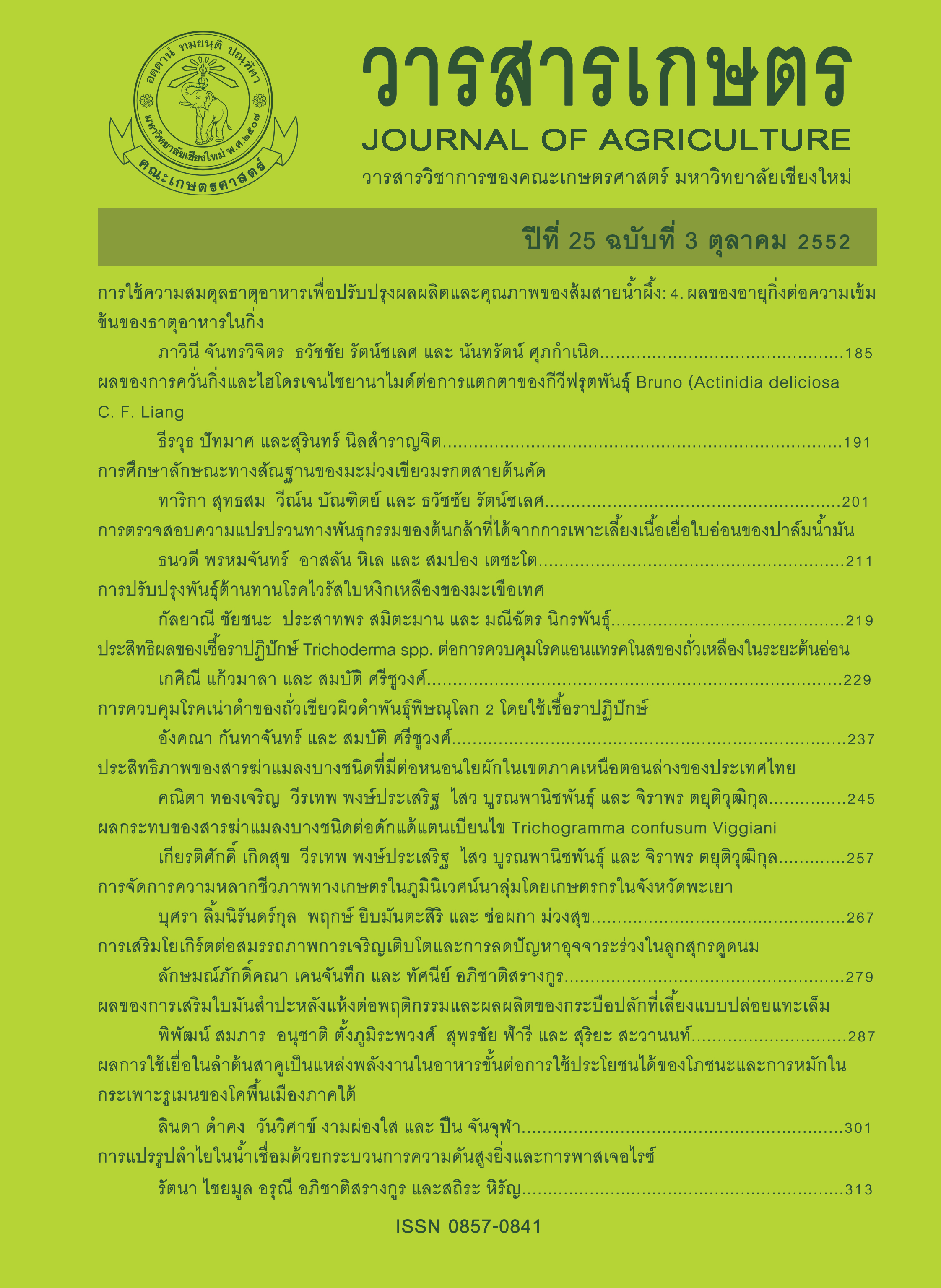ผลของการเสริมใบมันสำปะหลังแห้งต่อพฤติกรรมและ ผลผลิตของกระบือปลักที่เลี้ยงแบบปล่อยแทะเล็ม
Main Article Content
บทคัดย่อ
ศึกษาอิทธิพลของการเสริมใบมันสำปะหลังแห้งและการปล่อยแทะเล็มในช่วงเวลาต่างกันต่อพฤติกรรมและการให้ผลผลิตของกระบือปลัก ดำเนินการทดลองในช่วงเดือนมีนาคมถึงมิถุนายน 2551 ณ ศูนย์วิจัยและบำรุงพันธุ์สัตว์สุรินทร์ จังหวัดสุรินทร์ โดยแบ่งการทดลองออกเป็น 2 ช่วง ช่วงละ 40 วัน คือในฤดูแล้งและต้นฤดูฝน โดยมีระยะพักระหว่างช่วง 20 วัน กระบือปลักสาวอายุ 2 ปี จำนวน 18 ตัว ถูกแบ่งออกเป็น 6 กลุ่ม กลุ่มละ 3 ตัว โดยให้แต่ละกลุ่มมีน้ำหนักตัวเฉลี่ยใกล้เคียงกัน สุ่มกระบือให้ได้รับทรีทเมนต์ ๆ ละ 2 กลุ่มดังนี้ 1) ปล่อยกระบือแทะเล็ม 24 ชั่วโมง 2) ปล่อยแทะเล็มเฉพาะเวลากลางวัน และ 3) ปล่อยแทะเล็มเฉพาะเวลากลางคืน โดยแยกเลี้ยงในแปลงหญ้ารูซี่ขนาด 3 ไร่ กระบือที่ปล่อยแทะเล็มเฉพาะเวลากลางวันหรือกลางคืน เมื่อไม่ปล่อยแทะเล็ม จะถูกเลี้ยงไว้ในคอก ซึ่งมีน้ำสะอาดให้ดื่มและแร่ธาตุก้อนให้เลียตลอดเวลา โดยในแต่ละวันจะมีการเสริมใบมันสำปะหลังแห้งให้เฉลี่ยตัวละ 1 เปอร์เซ็นต์ของน้ำหนักตัว กิจกรรมต่าง ๆ ของกระบือจะถูกบันทึก โดยใช้วิธีการสังเกตสัตว์แต่ละตัวโดยตรงทุก ๆ 5 นาที เป็นเวลา 3 วัน ในแต่ละช่วงของการทดลอง ผลจากการศึกษาพบว่ากระบือที่ปล่อยแทะเล็ม 24 ชั่วโมง ใช้เวลาในการแทะเล็มนานกว่า (P<0.05) และ มีจำนวนมื้อในการแทะเล็มมากกว่า (P<0.05) แต่ใช้เวลาในการเคี้ยวเอื้องไม่แตกต่างจากกระบือที่ปล่อยแทะเล็มเฉพาะกลางวันหรือกลางคืน การเสริมใบมันสำปะหลังแห้งทำให้กระบือกินอาหารได้มากกว่า (P<0.05) กลุ่มไม่เสริมที่ปล่อย แทะเล็มตลอด 24 ชั่วโมง ในฤดูแล้ง กระบือที่ได้รับการเสริมใบมันสำปะหลังแห้งสามารถรักษาน้ำหนักตัวให้คงที่ ในขณะ ที่กระบือที่ปล่อยแทะเล็ม 24 ชั่วโมงสูญเสียน้ำหนักตัวเฉลี่ย 0.13 กิโลกรัมต่อวัน ส่วนในช่วงต้นฤดูฝนแม้ว่ากระบือทั้ง 3 กลุ่มจะมีน้ำหนักตัวเพิ่มขึ้น แต่กลุ่มที่ได้รับการเสริมใบมันสำปะหลังแห้งมีการเจริญเติบโตสูงกว่ากลุ่มที่ไม่เสริมอย่างมีนัยสำคัญ (0.61 และ 0.77 เทียบกับ 0.33 กิโลกรัมต่อตัวต่อวัน ในทรีทเมนต์ที่ 2, 3 และ 1 ตามลำดับ, P<0.05) การศึกษาครั้งนี้ชี้ให้เห็นว่าการเสริมใบมันสำปะหลังแห้ง จะช่วยทำให้กระบือที่ปล่อยแทะเล็มมีผลผลิตเพิ่มขึ้นโดยเฉพาะอย่างยิ่งในช่วงฤดูแล้ง
Article Details
เอกสารอ้างอิง
พิพัฒน์ สมภาร. 2550ก. อิทธิพลของการแทะเล็มใน เวลากลางวันหรือกลางคืนต่อพฤติกรรมของกระบือปลักสาว. ว. สงขลานครินทร์ วทท. 29(2): 413-425.
พิพัฒน์ สมภาร. 2550ข. อิทธิพลของขนาดกลุ่มต่อพฤติกรรมการแทะเล็มในเวลากลางคืนของกระบือปลักสาว. แก่นเกษตร 35(2): 264-275.
Adams, D.C. 1985. Effect of time supplementation on performance, forage intake and grazing behavior of yearling beef steers grazing russian wild ryegrass in the fall. J. Anim. Sci. 61(5): 1037-1042.
Chacon, E.A. and T.H. Stobbs. 1976. Influence of progressive defoliation of a grass sward on the eating behavior of cattle. Aust. J. Agric. Res. 27: 709-729.
Commonwealth Scientific and Industrial Research Organization. 1990. Feeding Standards for Australian Livestock: Ruminants. CSIRO Publications, East Melbourne. 266 pp.
Forbes, J.M. 1986. The Voluntary Food Intake of Farm Animals. Butterworths, London. 206 pp.
Fukushima R.S. and B. A. Dehority. 2000. Feasibility of using lignin isolated from forages by solubilization in acetyl bromide as a standard for lignin analyses. J. Anim. Sci. 78: 3135-3143.
Granum, G., M. Wanapat, P. Pakdee, C. Wachirapakorn and W. Toburan. 2007. A comparative study on the effect of cassava hay supplementation in swamp buffaloes (Bubalus bubalis) and cattle (Bos indicus). Asian-Aust. J. Anim. Sci. 20: 1389-1396.
Hahn, G.L. 1999. Dynamic responses of cattle to thermal heat loads. J. Anim. Sci. 77 (Suppl.2): 10-20.
Hales, J. S. 1973. Physiological responses to heat. pp.107-162. In: D. Robertshaw (ed.). MTP International Review of Science. Physiology Series 1, Vol. 7. Butterworths, London.
Hubbard, K. G., D.E. Stookesbury, G.L. Hahn and T.L. Mader. 1999. A climatological perspective on feedlot cattle performance and mortality related to the temperature-humidity index. J. Prod. Agric. 12: 650–653.
Janjai, S., J. Laksanaboonsong, M. Nunez and A. Thongsathitya. 2005. Development of a method for generating operational solar radiation maps from satellite data for a tropical environment. Solar Energy 78: 739-751.
Jung, H.G., D.R. Mertens and A.J. Payne. 1998. Correlation of acid detergent lignin and klason lignin with digestibility of forage dry matter and neutral detergent fiber. J. Dairy Sci. 80: 1622-1628.
Livestock Conservation Institute. 1970. Patterns of Transit Losses. Livestock Conservation Institute, Omaha, NE.
Milford, R. and D.J. Minson. 1966. Intake of tropical pasture species. pp. 815-822. In: Proceedings of the 9th International Grassland Congress, Sao Paulo.
Murray, M.G. 1991. Maximizing energy retention in grazing ruminants. J. Anim. Ecol. 60: 1029-1045.
National Research Council. 1981. Effect of Environment on Nutrient Requirements of Domestic Animals. National Academy Press, Washington, D.C. 152 pp.
National Research Council. 1996. Nutrient Requirements of Beef Cattle. 7th revised ed. National Academy Press, Washington, D.C. 242 pp.
Osuji, P.O. 1974. The physiology of eating and the energy expenditure of the ruminant at pasture. J. Range Manage. 27: 437-443.
Penning, P.D. 2004. Animal-based techniques for estimating herbage intake. pp.53-93. In: P.D. Penning (ed.). Herbage Intake Handbook. British Grassland Society, Reading.
Phillips, C.J.C. and K. Hecheimi. 1989. The effect of forage supplementation, herbage height and season on the ingestive behaviour of dairy cows. Appl. Anim. Behav. Sci. 24: 203-216.
SAS. 2000. SAS OnlineDoc, Version 8 with PDF Files. SAS Institute Inc., Cary.
Sharrow, S.H. 1984. A simple disc meter for measurement of pasture height and forage bulk. J. Range Manage. 37: 94-95.
Silanikove, N. 2000. Effects of heat stress on the welfare of extensively managed domestic ruminants. Livest. Prod. Sci. 67: 1-18.
Somparn, P. 2004. Intensive grazing management strategies for managing swamp buffaloes during thermal stress. Ph.D. Thesis, Kasetsart University, Bangkok. 143 pp.
Wanapat, M., C. Wachirapakorn, S. Chanthai, and K. Sommart. 1992. Utilization of cassava leaf (Manihot esculenta Crantz) in concentrate mixtures for swamp buffaloes in Thailand. In: Proceedings of Feeding Strategies for Improving Ruminant Productivity in Areas of Fluctuating Nutrient Supply. FAO/IAEA, Vienna.
Yousef, M.K. 1985. Stress physiology: definition and terminology. pp. 3-7. In: M.K. Yousef (ed.). Stress Physiology in Livestock. Volume I. Basic Principles. CRC Press, Boca Raton.


